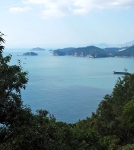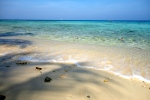This weekend’s temple stay at Beomeosa Temple was a pretty cool experience. Jon found it quite spiritual. I, basically lacking all spirituality (I do feel something akin to spiritual when I am in nature, but never as a connection to a higher being) found it less so. That didn’t detract from the experience for me though, because it was still a very unique and illuminating two days. And the surrounding nature was awesome. I loved this tree. I have about eight photos of this tree!

Buddhism was brought to Korea from China and India in the 3rd century. Korea claims itself as the place where traditional Buddhism is still practiced in its’ purest form. Knowing nothing of Buddhism, but a fair bit of Korea, I have reason to doubt this claim. Regardless, it has been in Korea for a very long time and is a big part of Korean heritage.
The first thing we learned at the temple stay was proper ‘mindful’ hand placement and how to do prostrations (bows). I tell you, those bows are not as easy as they look! Especially once you start doing them in the hundreds…but I get ahead of myself. The monks use either a bamboo clapper or a hand bell shaped like a fish to signify various timings in the bowing process such as when to start, when to come up, and when to do your final bow (which is slightly different). The fish shaped wooden hand bell is a fish to represent the fact that fish’ eyes never close, even in rest, to remind us to keep our minds always open, always awake.
We took a tour of the temple’s museum, led by one of the monks and translated by a volunteer who spent the weekend with us, and it was one of the drier parts of the temple stay for me. We learned about some of the famous Korean monks – all male, in case you were wondering – and we saw a couple pieces of really old and enjoyable art on the Buddhist versions of hell.

Our first Su Nim
Though the monks normally eat in a specific four bowl ceremonial manner, we simply ate in a room from a sort of buffet. The food was quite good, for the most part, and since it was vegan I especially enjoyed all of the choices. Su nim (the Korean word for monk, and what we called ours) was very kind and told us to eat as much as we needed to feel satisfied, up to and including seconds, but was sure to repeat that we were expected to eat everything that touched our plate. Nothing was to be left, and in fact, we would all happily sit and wait if someone needed additional time to finish. I liked this because I think we should all be mindful of waste, and fortunately it never came down to waiting on someone to shove their last bites in. 😉

At 6:30 each night, just after dark at this time of year, a drum ceremony signals the start of the evening service. Some of the monks go up to the drum area (I couldn’t get a great photo, unfortunately, because of the low light) and play the large, leather drum for at least ten minutes. They switch off because it is intense. In an awesome, awe-inspiring, really wonderful way. Such a performance! First, the leather drum to guide the sentient beings of the Earth. Apparently in the morning the drum is played from softer to louder, to awaken the day. In the evening it was played from louder to softer, to close the day. Then the metal cloud shaped bell is played briefly to guide the sentient beings of the sky, then the wooden fish shaped bell to guide the sentient beings of the sea, and finally the large iron bell to guide the souls of all sentient beings in hell. (I may have gotten some of those confused with their respective bell types…forgive me! And let me know if you know better!) But seriously, if you get a chance to go to Beomeosa Temple for any reason, plan to be there for the drum ceremony. It blew us away.
Now, you may have picked up on the fact that the first drum is leather. Yet Buddhism encourages all living things, including insects, to be treated with care and not to be intentionally harmed. Soooo….didn’t a cow die for that drum and every other drum like it? I asked the monk why this was tolerated, when we had just finished a vegan meal. He basically, and honestly, told me that it was wrong but that it was done anyways. The leather was from a female cow, hard working and at the end of her life. Apparently the female cow piece is important, as they make better sounding drums…?? I wanted to ask more questions (as you can imagine) but just didn’t feel like getting into a translated argument with a monk 🙂

Immediately following the drums, we went to the Main Buddha Hall to join the monks for evening service. Another incredible moment in our stay! We bowed and chanted (more like sang) with the monks. Well, we didn’t really chant, but we listened and felt the place rumble with it all. It was a pretty neat experience to be there with them and feel their energy. Jon especially felt this part of the stay resonated with him, because at the very least one could not escape the spirituality of the monks and the intensity of their devotion to their beliefs in that moment. It was pretty neat that they let us be part of that and witness to it. Not totally dissimilar to a church service, but more heartfelt than my experiences with most church services. And of course, a lot more bowing!
Next came the hard part. We made our 108 prayer beads, which meant 108 full prostrations. All the way down and all the way back up. After the down part, we would quickly string a bead, then rise all the way up and then back down again. It was very fast paced and quite the workout! We were all sweating and huffing by the end. The idea with the prayer beads is actually quite nice – with each bead strung, you are to make a wish for your happiness. I gathered that it could be specific or more general. I tried to spend my praying time just pondering how we become, create, and maintain happiness (since I do not pray). Unfortunately, they had us bowing and stringing at such a speed that a lot of the potential for deep thought and connection to the moment we were in was lost while trying to do everything quickly enough to keep up. However, we do each have our very own prayer beads now. And our legs are still sore from the workout!

I was curious to know why the 108 prayer beads – where did 108 come from? So I asked Su Nim and this is what he said: We sense the world with 6 organs – eyes, ears, mouth, nose, hands (touch), and mind. We can feel those in 3 ways – like, dislike or neutral. That gives us 6 x 3 for 18. Then that is multiplied by 3 again for the past, present, and future. Now we have 54. Times 2 for the choice we have to accept or deny everything. And there is 108! Phew, eh? Also, at the end of our prayer beads are 4 beads of mercy. The monks will pull off a bead of mercy and throw it over a dead animal, should they come across one, as a prayer that their soul finds a better life elsewhere (I think – translations can be hard).
All of the girls slept in a room together and all of the boys slept in a different room together. This was easily the worst part of the entire experience. People. Are. So. Inconsiderate. AGH. Suffice to say that if you decide to do a temple stay, bring a sleep mask and ear plugs and avoid caffeine after lunch that day. Lights are out at 10pm and you’re up at 3 or 5am, depending on your stay. Koreans seem to function on about 2 hours of cell-phone free sleep a night and will keep you awake without regard. If you are not the same way and want some shuteye, go prepared!

At least the morning view was cheering 🙂
The next morning we had a short morning service and meditation, breakfast (very similar to dinner), and enjoyed a group walk up to a hermitage. I didn’t know what that was, so don’t feel bad if you don’t either! It turns out hermitages are like satellite temples spanning the area directly around the ‘mother’ temple. They tend to just be more intimate, and sometimes more quiet. This one was both of those things as it sat higher up in the mountain and saw way less visitors. We sat for a while and chitter chattered a bit and just enjoyed the silence.

When we went back down, we had a two hour tea ceremony and that was our time to ask Su Nim questions. He also asked us questions. Mostly, people wanted to know how to find inner peace from our emotions. Su Nim basically said that practice makes perfect. He suggested treating your feelings as outside of yourself, acknowledging them, setting them apart from you, realizing they aren’t special from other people’s feelings (we all have struggles), and then actively letting them go. There are pieces of that which make a lot of sense to me and the reminder was a good one.

Second Su Nim
Jon was our tea master. He poured that tea like a champ!

After that, it was a short closing ceremony and reflection, and we were off. We certainly learned a lot about Korean Buddhism and it was fun to learn how to do bows and make prayer beads. I had personally hoped for just a touch more meditation time, maybe a little more quiet, but the experience was overall a good one and one of our better experiences in Korea. I recommend you give it a try if you have never had a temple stay experience before!
Buddhism is, unsurprisingly, not for me. At least not the Korean variety. I saw worship to a deity (or dead person) and male importance similar to those I have found in other religions, and which always leaves me cold. Also, bits of hypocrisy (remember the animal skin drum?) and a belief in heaven and hell, and subsequently an afterlife in which you are judged, are not for me. Still so glad we did it. Some of the people there were Hindu, others maybe a little Christian (though I don’t think practicing), some atheist or agnostic, some Buddhist, and some likely undecided. There was a real mixture so whatever your faith (or lack of), I think there is probably something to be gained regardless.

Here is the English website for Beomeosa if you are interested in their programs. We did the Resting Rest stay, which is apparently one of the calmer and less “full” options. http://www.beomeo.kr/eng_templestay/idt.php
































































